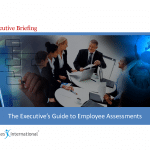Hiring managers are essentially the gatekeepers of a company, because they have the largest influence over a candidate’s admission. But, with this authoritative position and essential responsibility comes the demand to hire the right job fit while preventing employee turnover within the company. This can be a challenging process because hiring managers are, for lack […]
Three Reasons Why Productivity Fluctuates
Tags: 4 branches of emotional intelligence, be a better leader, developing employees, developing high performance employees, emotional intelligence, Emotional Intelligence: Why It Can Matter More Than IQ, employee assessments, identifying top employees
The May, 2004 edition of Harvard Business Review featured an article on how it is risky to hire top performers from other companies. They advised that we are better off growing our own stars rather than headhunting our competitors. Why would that be? There are of course several reasons, but what is the recurring theme? […]
Emotional Intelligence: The power of the sliver
Tags: 4 branches of emotional intelligence, coaching, developing employees, emotional intelligence, Emotional Intelligence: Why It Can Matter More Than IQ
Many of us loved the movie The Matrix as there were so many analogies and metaphors that resonated with how we experience life. One of my favorite lines came from Morpheus (played by Laurence Fishburne), the brilliant leader who searched his whole life for Neo, the messiah-like hero who was chosen to save the world […]
9 Sales Practices You Should Always Follow
Tags: be a better sales person, developing employees, developing high performance employees
Landing a job in sales is one thing, but being successful in sales can prove to be a much more challenging and stressful task. There are a couple of reasons job boards are always flooded with open sales positions: Working in sales isn’t for everyone. If the stress of quotas and performance-based job security is […]
Do You Remember Milli Vanilli?
Tags: 4 branches of emotional intelligence, be a better leader, customer service, developing employees, emotional intelligence, Emotional Intelligence: Why It Can Matter More Than IQ, talent management
Do you remember Milli Vanilli? I know, blast from the past. They were a pop-artist group from the late 80’s and early 90’s with popular songs like “Blame it on the Rain” and “Girl, You Know it’s True”. They were not only made famous by those songs, but by a much more powerful fact: they […]
Staying on Track with Your New Year’s Resolutions
Tags: be a better leader, be a better sales person, coaching, developing employees, employee assessments, keeping new years resolutions, new years resolutions
Now that we’re a few months into 2015, it’s a good time to follow up on those New Year’s resolutions you made before the ball dropped and you went back to business as usual. Maybe your resolutions were personal in nature such as exercise more or stop smoking. If you had aspirations to improve your […]
How to Execute with any Audience with Interests
Tags: developing employees, employee assessments, employee interests, leadership qualities, sales assessments, team engagement
In our past articles, we reviewed the Thinking Style and Behavior Traits Sections of the Profiles PXT and PSA assessments. Based on a real world example of a 12 person team, we can see from their Profiles Sales Assessment Concurrent Performance Model Overview that differences in perspectives, comfort zones and cognitive abilities, can create real […]
How to Execute with any Audience with Thinking Style
Tags: coaching, developing employees, employee assessments, keys to decision making, sales assessments, team building tips
Over the past couple of months, we’ve focused on the Behavior section of the Profiles Sales Assessment Concurrent Performance Model Overview in order to show how a 12 person team might create a tension free environment by properly executing an assessment. Read all of the posts here! Let’s now focus on the Thinking Style section […]
How to Execute with Any Audience with Energy Level
Tags: coaching, developing employees, employee assessments, managing an employee with high energy, multi tasking, sales assessments, team building tips
We hope you’re enjoying this blog series on How to Execute with ANY Audience where we show a real world example of a Profiles Sales Assessment Concurrent Performance Model Overview and offer our consulting advice to team members on how each other might view certain situations. We looked at the Sociability, Attitude, Independence, Manageability and […]
How to Execute with any Audience with Assertiveness
Tags: developing employees, employee assessments, leadership qualities, managing difficult employees, sales assessments, team building tips, team engagement
Over the last few weeks, we’ve identified how to execute an employee assessment by focusing on the Attitude, Independence and Manageability Behavior sections of the Profiles Sales Assessment Concurrent Performance Model Overview, We now wish to Focus on the Assertiveness Behavior to provide us with another excellent example of how to use this report to […]
How to Execute with ANY Audience with Manageability
Tags: coaching, developing employees, employee assessments, leadership qualities, managing difficult employees, managing independent employees, sales assessments, talent management, team building tips
As we continue our series of blog posts that focus on sections of a real world example of a Profiles Sales Assessment Concurrent Performance Model Overview, we hope that you’re gaining a better perspective on how to execute an assessment. If not, we offer personalized consulting services to support the assessment results of your employees. […]
How to Execute With ANY Audience With Attitude
Tags: coaching, developing employees, employee assessments, leadership qualities, managing difficult employees, red zone, team building tips
Last month, we discussed how to utilize the data from our Profile Leadership tools to OPTIMIZE your interactions with employees, people you’re interviewing, your sales team, etc. We gave examples of ways to interpret the results of the Sociability Behavior section of the Profiles Sales Assessment Concurrent Performance Model Overview in order to create a […]
How to Execute with ANY Audience with Independence
Tags: coaching, developing employees, employee assessments, leadership qualities, managing difficult employees, managing independent employees, sales assessments, team building tips
In this series of blog posts, we are showing real life examples of how to utilize the data from our Assessments to gain a better perspective on how you and your team might view certain situations and areas of conflict. We looked at the Sociability & Attitude Behavior sections of the Profiles Sales Assessment Concurrent […]
How to Execute With ANY Audience
Tags: coaching, developing employees, employee assessments, sales assessments, team building tips
No, we are not here today to discuss how to “eliminate” those hard to reach audiences. Quite the contrary! We want to give you a taste of how to utilize the data from our Profile Leadership tools to OPTIMIZE your interactions with those audiences such as employees, people you’re interviewing or your sales team. This is […]
Optimize Your Red Zone
Tags: coaching, developing employees, leadership qualities, recruiting, red zone
It’s the time of year for New Years resolutions and maybe yours is to manage your organization more efficiently while increasing production. Sounds like a lofty goal but not if you focus on the three areas of your business where you get the highest rate of return for your efforts. We call that, the RED Zone.
10 Important Questions to Help Identify High Potentials
Tags: coaching, developing employees, developing high performance employees, employee assessments, identifying top employees
According to a study by the Corporate Executive Board (CEB), as many as 25% of high-potential employees plan on leaving their jobs within a year. Many organizations make the mistake of only looking at ability when assessing an employee’s potential for managing a job. When trying to identify a high-potential (or HiPo) employee, it is […]









